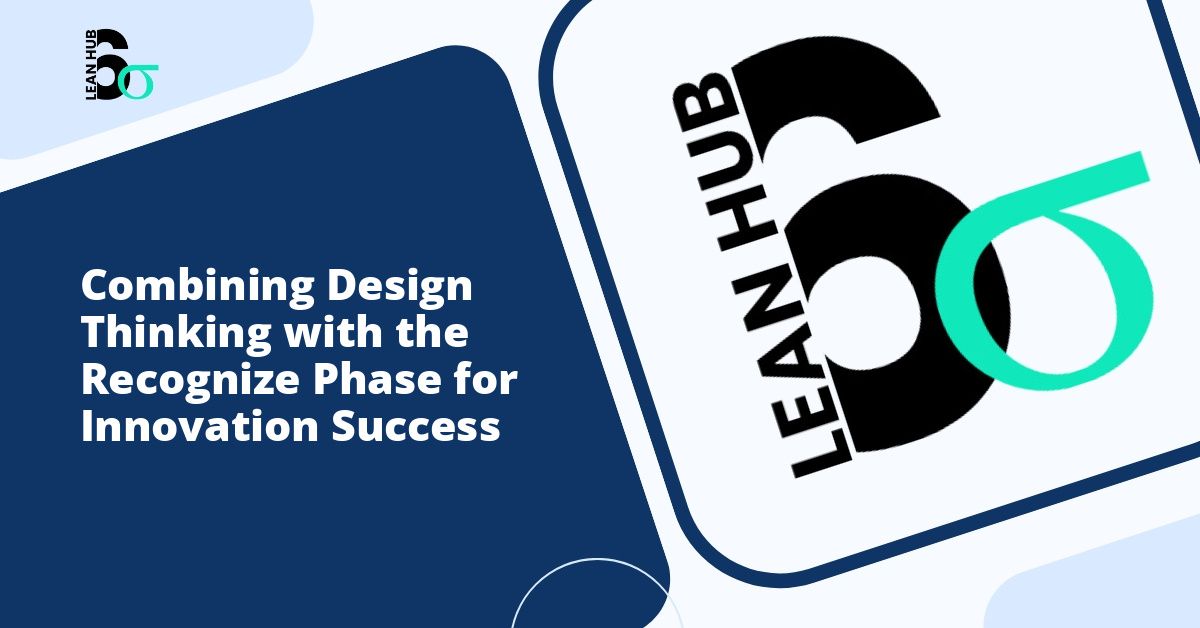In today’s rapidly evolving business landscape, organizations face the constant challenge of identifying problems worth solving while maintaining operational excellence. Two powerful methodologies have emerged as game-changers in this domain: Design Thinking and Lean Six Sigma. When combined strategically, particularly during the critical recognize phase, these approaches create a robust framework for driving meaningful innovation while maintaining process efficiency.
Understanding the Foundations
Before exploring how these methodologies complement each other, it is essential to understand their individual characteristics and strengths. Design Thinking represents a human-centered approach to innovation that emphasizes empathy, experimentation, and iterative learning. Meanwhile, lean six sigma provides a data-driven methodology focused on eliminating waste and reducing variation in business processes. You might also enjoy reading about RDMAIC vs DMAIC: Why the Recognize Phase Matters in Lean Six Sigma.
The recognize phase serves as the crucial starting point in problem-solving initiatives. This initial stage involves identifying opportunities for improvement, understanding the scope of challenges, and determining which problems deserve attention and resources. By integrating Design Thinking principles into this phase, organizations can enhance their ability to uncover hidden opportunities and frame problems in ways that lead to more innovative solutions. You might also enjoy reading about Recognize Phase in Call Centers: Identifying Customer Service Gaps with Lean Six Sigma.
The Recognize Phase in Lean Six Sigma
The recognize phase forms the foundation of any successful process improvement initiative. In traditional lean six sigma applications, this phase focuses on identifying gaps between current performance and desired outcomes. Organizations typically examine metrics, customer feedback, and operational data to pinpoint areas requiring attention. You might also enjoy reading about Stakeholder Analysis: Who Needs to be Involved in Problem Recognition?.
However, the conventional approach sometimes struggles with truly innovative problem identification. Teams may focus too narrowly on obvious metrics or existing processes, potentially missing opportunities that lie outside traditional boundaries. This limitation becomes particularly evident when organizations face complex, ambiguous challenges that require creative thinking and fresh perspectives.
Common Challenges in Traditional Recognition
- Overreliance on historical data without considering emerging trends
- Limited stakeholder engagement during problem identification
- Tendency to focus on symptoms rather than root causes
- Insufficient consideration of user experience and emotional factors
- Narrow framing that restricts potential solution spaces
Design Thinking as a Complementary Approach
Design Thinking brings a refreshing perspective to problem recognition through its emphasis on empathy and human-centered exploration. This methodology encourages teams to deeply understand the people affected by problems before attempting to define or solve them. The approach involves observing behaviors, conducting interviews, and immersing oneself in the user’s environment to gain authentic insights.
When applied to the recognize phase, Design Thinking helps teams move beyond surface-level observations to uncover latent needs and unarticulated problems. This deeper understanding often reveals opportunities that traditional data analysis might miss, particularly those related to user experience, emotional responses, and behavioral patterns.
Integrating Design Thinking with the Recognize Phase
The integration of Design Thinking with the recognize phase creates a powerful hybrid approach that combines analytical rigor with creative exploration. This combination allows organizations to maintain the discipline and structure of lean six sigma while incorporating the innovative spirit of Design Thinking.
Step One: Empathetic Discovery
Begin by expanding the traditional data collection methods used in lean six sigma to include qualitative research techniques. Conduct ethnographic observations, contextual interviews, and shadowing exercises to understand how people actually experience current processes. This empathetic discovery phase reveals pain points, frustrations, and unmet needs that quantitative data alone might not capture.
Document not just what people do, but why they do it, how they feel about it, and what workarounds they have developed. These insights provide rich context that transforms raw metrics into meaningful stories about human experiences.
Step Two: Collaborative Problem Framing
Engage diverse stakeholders in collaborative sessions to synthesize findings and frame problems from multiple perspectives. Use visual tools like journey maps, empathy maps, and experience diagrams to create shared understanding across the team. This collaborative approach ensures that the recognize phase captures a holistic view rather than a single department’s perspective.
Encourage participants to question assumptions and challenge conventional definitions of problems. Sometimes the most significant innovations come from reframing what everyone assumed was the problem in the first place.
Step Three: Opportunity Identification
Transform observations into actionable opportunity statements that inspire innovation. Rather than simply stating problems, frame them as “How Might We” questions that open up possibility spaces. This technique, borrowed from Design Thinking, maintains the focus on user needs while inviting creative solution exploration.
For example, instead of recognizing a problem as “customer service response time exceeds target,” reframe it as “How might we create customer support experiences that feel immediate and personalized?” This reframing maintains the measurable concern about response time while opening pathways to innovative solutions.
Practical Benefits of the Combined Approach
Organizations that successfully integrate Design Thinking with the recognize phase of lean six sigma report several significant advantages. These benefits extend beyond simply finding more problems to solve; they fundamentally improve how organizations approach innovation and improvement.
Enhanced Problem Relevance
By grounding problem recognition in genuine human needs and experiences, teams ensure they work on challenges that truly matter. This relevance increases stakeholder buy-in and improves the likelihood that solutions will be adopted and valued.
Broader Solution Possibilities
When problems are framed through both analytical and empathetic lenses, the potential solution space expands dramatically. Teams feel empowered to consider innovative approaches alongside traditional process improvements, leading to breakthrough thinking rather than incremental changes.
Improved Cross-Functional Collaboration
The collaborative nature of Design Thinking naturally breaks down silos during the recognize phase. When diverse team members jointly explore problems through empathy-building activities, they develop shared understanding and commitment that persists throughout the improvement journey.
Faster Validation
Problems identified through this combined approach come pre-validated through direct user research and data analysis. This dual validation reduces the risk of pursuing improvement projects that ultimately fail to deliver meaningful value.
Implementation Best Practices
Successfully combining these methodologies requires thoughtful implementation and organizational commitment. Leaders should consider several best practices when introducing this integrated approach.
First, invest in training that helps team members understand both methodologies and their complementary strengths. Practitioners do not need to become experts in both approaches, but they should appreciate how each contributes to comprehensive problem recognition.
Second, allocate sufficient time for the enhanced recognize phase. The addition of Design Thinking activities requires more upfront investment than traditional approaches, but this investment pays dividends through better-defined problems and more innovative solutions.
Third, create safe spaces for exploration and experimentation during problem recognition. Encourage teams to pursue unexpected insights and challenge established assumptions without fear of criticism or failure.
Finally, document and share learnings across the organization. As teams gain experience with this integrated approach, their insights and refinements should be captured and distributed to accelerate organizational learning.
Measuring Success
Organizations should establish metrics that reflect the enhanced value of this combined approach. Beyond traditional lean six sigma measures of process improvement, consider tracking indicators such as solution adoption rates, user satisfaction improvements, time to value realization, and the ratio of breakthrough innovations to incremental improvements.
These expanded metrics help demonstrate the full value of investing in a more comprehensive recognize phase that integrates Design Thinking principles with lean six sigma discipline.
Conclusion
The integration of Design Thinking with the recognize phase represents a powerful evolution in how organizations approach innovation and continuous improvement. By combining the analytical rigor of lean six sigma with the empathetic exploration of Design Thinking, teams can identify more meaningful problems, frame them in more inspiring ways, and set the stage for truly innovative solutions.
This combined approach acknowledges that effective innovation requires both heart and mind, intuition and analysis, creativity and discipline. Organizations that master this integration position themselves to thrive in an increasingly complex and rapidly changing business environment where recognizing the right problems to solve becomes as important as solving them effectively.








